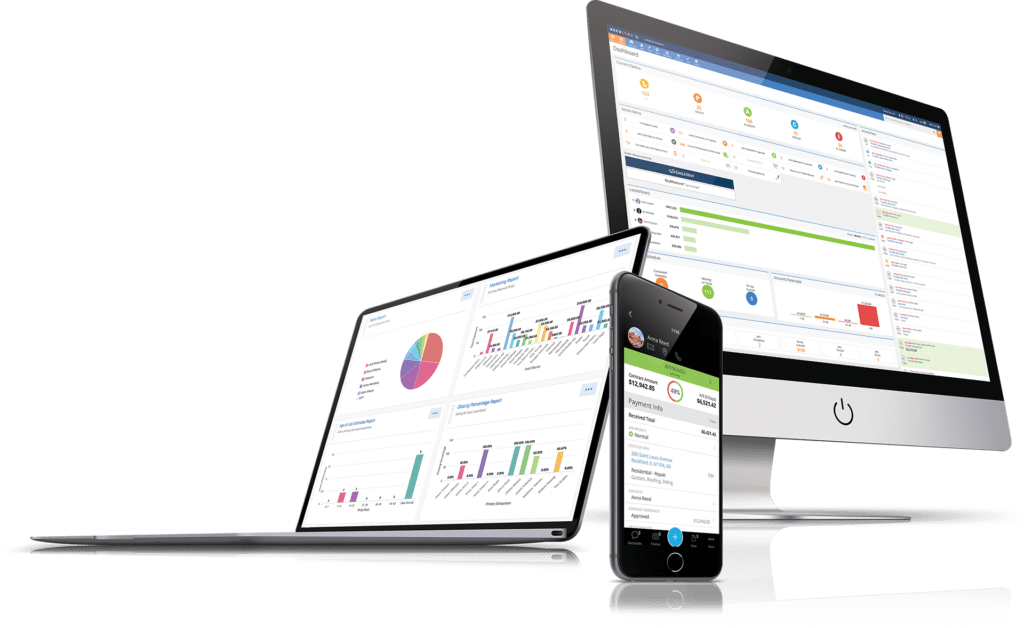Customer relationship management, or CRM, software is designed to help you manage your roofing business more effectively. From the moment a lead comes in the door to the day the final invoice is submitted, roofing CRM software can streamline your processes so you can increase your efficiency and grow your profits.
Since CRM software is so helpful for so many aspects of managing a business, many contractors wonder if it can also help with their marketing. CRM software isn’t designed as a marketing tool—it won’t find new leads for you, help you design marketing materials, or host your website. But there are ways to use CRM software to enhance your roofing company marketing and help make it more effective. Here are a few ways to use your CRM to improve the way you market your roofing business.
4 Ways to Use Your CRM for Better Roofing Company Marketing
#1: Evaluating if Your Marketing Strategies are Working
Good data is key to good marketing. If you don’t understand how your marketing is impacting your business, it’s hard to know if you should keep using your current marketing strategies or make adjustments to reach more homeowners. Taking a deep dive into your business data can help you evaluate your marketing performance and make decisions for future marketing.
Roofing contractor business software can help you collect the performance data you need. With the reporting dashboard in some CRMs, you can see how your revenue has grown this year, identify which of your jobs were most profitable, and evaluate your closing percentage. Digging into these particular results can help you answer some important questions about your marketing:
- Are we reaching enough leads?
- Are the leads we generate well-qualified? Do they have a good chance of closing?
- Are we targeting the geographic areas or trades that bring us the most profit?
Looking at the data provided by your roofing CRM to find answers to these questions will equip you to make smarter marketing decisions.

#2: Improving Lead Follow-Up
Once a lead enters your pipeline, what happens next? Prompt follow-up is key to turning leads into customers. If it seems like your leads aren’t panning out, shortening the time it takes you to follow up with them might help you close more deals.
The automation tools in some roofing CRMs can help you stay on top of follow-up and simplify the process of reaching out to leads. You can set up automated tasks for your salespeople that trigger whenever a lead is added to the system, reminding them to reach out to those leads. You can also put together automated emails promoting your services that will be sent to your leads once they’re added to the system. Using automations to handle follow-up will help ensure that your leads are contacted in a timely manner, making it more likely that they will turn into jobs.
#3: Finding New Leads to Target
In order to make the most of your marketing budget, it’s important to find potential growth areas for your marketing efforts. Are there untapped or underutilized lead sources that might yield new customers? Which lead sources have been the most effective for your business, and could you spend more efforts on those sources? Understanding where your leads come from and identifying gaps in your lead generation will help you reach as many potential customers as possible.
Some roofing CRMs allow you to run a lead source report, which gives you an in-depth look at where your leads are coming from. Looking at this report can help you more clearly see which lead sources are most valuable, which ones present an opportunity to reach more people, and if any are not working for your business. You can reallocate marketing resources from tapped-out or ineffective lead sources and target leads in other ways. Using your roofing CRM to find lead source information will help you create your 2021 marketing budget and inspire you with new potential customers to target.
Read: How Roofing Software Can Help Grow Your Small to Medium Roofing Businesses
#4: Keeping Information Organized
Great marketing, great leads, and great follow-up can go to waste without great organization. Turning leads into customers and delivering great work for those customers is much simpler when you can easily find job information whenever you need it. Your roofing business needs a system to keep all your information secure, up-to-date, and in a single location.
Roofing CRMs provide a strong organizational structure that can benefit your roofing business. In particular, cloud-based CRMs allow everyone on your team to access information from anywhere. This means that if a potential customer calls your office and expresses a concern about their roof, a salesperson in the field can see all the information about that concern before they knock on that person’s door. Keeping all your teams in the loop with a CRM will result in more jobs sold and better customer service on those jobs.
In addition, CRMs save records of emails, text messages, and tasks around a given job, making it easy to see which leads have been followed up with and what has already been communicated to those leads. If you have questions about past communications, you can look back at these records to get the answers. This eliminates duplicate follow-up, increases accountability, and helps improve communication with potential customers.
Enhancing Your Roofing Company Marketing with CRM Software
While a CRM won’t do your marketing for you, you can use the tools in your roofing CRM to improve your lead follow-up, evaluate your marketing strategies, find new potential customers to reach, and keep all your leads more organized. Taking advantage of your roofing CRM system in this way can give your roofing company marketing a significant boost.

See a demo of the all-in-one roofing software designed to help you grow your business.

